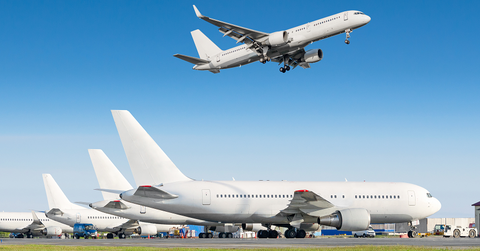Boeing 737 MAX Update: Quick Return to Service?
Boeing (BA) stock gained more than 2% on Tuesday. There’s hope that the Boeing 737 MAX planes might return to service quickly.
July 31 2019, Published 10:50 a.m. ET

Boeing (BA) stock gained more than 2% on Tuesday. There’s hope that the Boeing 737 MAX planes might return to service quickly. Investors were optimistic about the troubled jets after a Reuters report. According to the report, the FAA hopes that other major aviation regulators approve Boeing’s MAX planes.
Boeing 737 MAX update
According to Reuters, the information was in a letter sent by the FAA to Congress. Dan Elwell, the acting FAA administrator, wrote the letter to Senator Susan Collins and Senator Jack Reed. According to Reuters, Elwell “hopes to achieve near simultaneous approval from the major civil aviation authorities around the world.” He said, “We are working with our colleagues from the European Union, Canada and Brazil to address their concerns.”
The letter raised hopes that MAX planes might return to service by October. Industry experts think that the planes will return to service in December. Earlier, Boeing stated that it would submit a final certification in September. The company hoped to get regulatory approval in early October. Boeing’s CEO, Dennis Muilenburg, reaffirmed the September timeframe during the second-quarter earnings conference call on July 24.
During the call, he warned about lowering or completely halting 737 MAX production if the aircraft ban continues. However, Muilenburg added that this isn’t “something we want to do, but an alternative that we have to prepare for.” In April, Boeing reduced the monthly production of the MAX jets by 19% to 42 units due to frozen deliveries.
What’s troubling Boeing 737 MAX jet?
Boeing’s 737 MAX planes have faced worldwide grounding since mid-March following two deadly accidents within five months. A total of 346 people died in the crashes. The preliminary investigation report suggested a software glitch in the MCAS (Maneuvering Characteristics Augmentation System) or flight control system.
In April, Boeing claimed that it completed the software update on the MCAS system. Industry experts expected Boeing to get regulatory approval on the software update in early July. However, during a test on the simulator, the aviation regulatory body found a new issue with the MAX planes in late June.
The FAA pilots stated that the updated system takes longer to respond to a scenario where the aircraft’s nose is pitched down. The issue could slow down a pilot’s ability to react quickly and increase the risk of a crash.
The new software glitch lowered the expectations for the aircraft’s quick return to service. Boeing said it expects to get regulatory approval in early October. However, industry experts expected the new issue to delay the MAX’s return until late December.
How did the MAX fiasco hurt Boeing in Q2?
Ongoing troubles with 737 MAX planes hurt Boeing’s second-quarter financial results. Due to the MAX planes, the company recorded a $4.9 billion after-tax charge during the second quarter. The charge is related to an estimated cost of concession for MAX customers who have lost revenues and operating profit due to the grounding.
Notably, major US airlines face massive flight cancellations due to the MAX grounding. Together, Southwest Airlines (LUV), American Airlines (AAL), and United Airlines (UAL) own 72 MAX aircraft.
Southwest faced over 20,000 flight cancellations due to the worldwide ban on MAX jets in mid-March. American Airlines and United Airlines reported 7,800 and 3,440 flight cancellations in the second quarter. As a result, the three major US airlines reported sluggish top and bottom-line growth in the second quarter. The companies pressured Boeing to compensate them for revenue and profit losses due to the MAX grounding.
Therefore, Boeing kept aside $4.9 billion during the second quarter as a provision for compensating airlines. The after-tax charge reduced Boeing’s second-quarter revenues and pre-tax earnings by $5.6 billion. Also, the company’s 737 production costs increased by $1.7 billion in the second quarter due to the lower monthly output.
Due to frozen deliveries for MAX jets, Boeing’s overall commercial aircraft shipment fell 54% YoY to 90 units. Until the first quarter, the 737 MAX planes accounted for approximately 70% of Boeing’s total aircraft deliveries. As a result of the lower shipment, the company’s second-quarter revenues fell 35% YoY. Due to lower revenues and the after-tax charge, Boeing reported an adjusted loss of $5.82 per share in the second quarter.
Stock performance
Boeing stock has fallen significantly since the Ethiopian Airlines crash on March 10. The company’s YTD (year-to-date) gain fell to 7.7% as of Tuesday from nearly 31% as of March 8. The stock underperformed the broader market and the iShares U.S. Aerospace & Defense ETF (ITA). Major indexes, including the Nasdaq, the Dow Jones, and the S&P 500 have gained 24.7%, 20.2%, and 16.6%, respectively, YTD. ITA, which invests in aerospace and defense equipment manufacturers, assemblers, and distributors, has gained 25.4%.
